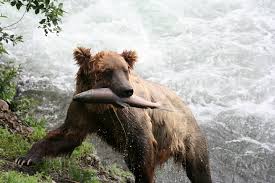
Information
Physical Description:
 This species is one of the largest living carnivores. On average, adult males are 8 to 10% larger than females but sizes vary according to the location of the species.
This species is one of the largest living carnivores. On average, adult males are 8 to 10% larger than females but sizes vary according to the location of the species.
Brown bears usually forage in the morning and evening and rest under dense vegetation during the day. Depending on the season, brown bears may travel hundreds of kilometers during the autumn to locate food supplies.
Hibernation lasts from around October/December to March/May. In certain southern areas however, hibernation is very short or may not occur at all. To hibernate, bears choose a location such as a burrow, located on a sheltered slope under a large stone or among the roots of a large tree. Dens may be used on repeated occasions over the years.
Size:
Brown bears can grow to a huge size, males up to 350kg, females to 200kg. The biggest brown bear was caught in Romania and weighed 480kg.
Colour:
Although the pelage of this species is usually dark brown, it can vary from cream to almost black depending on the location of the species. In the Rocky Mountains (USA), they have long hairs on the shoulders and back which are frosted with white.
Ecology & Habitat:
Brown bears can be found in many habitats, from the fringes of deserts to high mountain forests and ice fields. In Europe, the brown bear is mostly found in mountain woodlands, in Siberia it occurs primarily in forests while in North America they prefer tundra, alpine meadows and coastlines. The species' main requirements are areas with dense cover in which they can shelter by day.
Life Cycle:
Young born bears are vulnerable, being blind, naked and weighing only 340-680g. Cubs grow quickly, reaching 25kg by 6 months, and continue lactating for 18 to 30 months while eating a variety of foods. Cubs usually remain with the mother until the third or fourth year of their life. Although they mature sexually between 4-6 years of age, the species continues to grow until 10-11 years old. In the wild, the brown bears can reach 20 to 30 years of age. Despite this long life expectancy, most brown bears die very early.
Diet:

Brown bears are omnivorous, and their diet varies with the season - from grass and shoots in the spring to berries and apples in the summer, nuts and plums in autumn. All year round they eat roots, insects, mammals (including moose and elk in the Canadian Rockies), reptiles, and of course, honey. In Alaska, grizzlies feed on salmon during the summer.